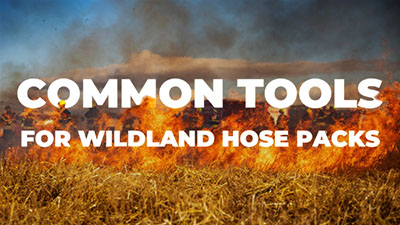Is Your Smokey Pack Ready?
Common Tools for Your Wildland Hose Pack
In 2022, more than 66,000 wildfires burned 7.6 million acres and over 2,700 structures were damaged or lost. In March of 2023, Wildfire predictive services suggested above normal fire potential in parts of west Texas, southern New Mexico, and across Florida. Wildfires present significant threats to life and property, and agencies across the country need to be ready at a moment’s notice.
What is a Smokey Pack?
Smokey Packs are common resources in a wildfire operation. These packs contain basic tools and equipment that allow wildland firefighters to quickly connect and supply water to different areas. Additionally, they are relatively lightweight and versatile, making it easy to adjust as conditions change.
Why Build a Smokey Pack?
Smokey Packs give your responding crews continuous water on the attack line even when transitioning from one pack to the next. The 1” line is the only line that is charged as it is being advanced while your heavier 1.5” lines remain dry (thankfully!) as they are deployed. Typically, multiple packs are needed. Once the fire is hooked, every 1” line you’ve laid out becomes a lateral line.
In the Pack
A typical Smokey Pack includes:
- 100’ of 1.5” hose
- 100’ of 1” hose
- 1” barrel nozzle
- 1.5” x 1” reducer
- 1.5” x dual 1.5” gated wye
Using Your Wildland Hose Pack
Preparing your Hose Pack
Getting your hose pack properly prepared is an important step. You can see how Los Angeles County Fire Department prepares their packs in this video. You can also search for other videos online to see how other departments prepare.
Los Angeles County starts by rolling their 1.5” hose line with the female coupling on the inside. From there, they thread the 1.5” male into the gated wye and install the reducer on one of the outlets. The next step is to connect the rolled 1” line with barrel nozzle to the reducer.
Now, it’s time to pack! Packing the line can be tricky. It’s important to tape the lines off with flagging to keep the contents together during packing and deployment and use all available space to fit the equipment.
A 1” Pack is similar to a Smokey Pack and uses the same contents except it carries two 100’ sections of 1”. This is the first pack used in setting up a hose lay towards the fire and away from the engine.
Deploying your Smokey Pack
Operationally, the first-in crew lays out a 1-3/4” crosslay as a trunk line. Then, you should completely remove the preconnected initial attack nozzle. If you have a 2-piece, you can leave the valve attached. Now, pull the first 1” line from the 1” pack and thread the trunk line into a separate gated wye. Charge the trunk line, then charge your 1” line.
This is where the Smokey Pack begins!
Grab the 1.5” roll out of your bag and connect it to the other outlet of the gated wye on the ground. Open the charged 1” barrel nozzle and begin attacking the fire while you walk along the perimeter, stretching the 1.5” line. When you reach the end of the 100’ of 1.5”, use the final gated wye with reducer to transition into a second Smokey Pack. This process can repeat itself until you hook the fire.
More Tools for Wildland Fires
All fires present limitless variables and the Smokey Pack may not provide everything you need. Other tools such as a BubbleCup or a Hose Clamp can also be used in an effective wildfire operation.
